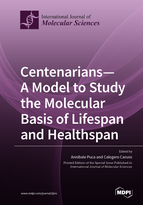Centenarians—A Model to Study the Molecular Basis of Lifespan and Healthspan
A special issue of International Journal of Molecular Sciences (ISSN 1422-0067). This special issue belongs to the section "Molecular Immunology".
Deadline for manuscript submissions: closed (31 May 2020) | Viewed by 66666
Special Issue Editors
2. Cardiovascular Research Unit, IRCCS MultiMedica, 20138 Milan, Italy
Interests: genetics of exceptional longevity; immunological phenotype of exceptional long living individuals; BPIFB4, a longevity associated protein, and its isoforms in health and diseases
Special Issues, Collections and Topics in MDPI journals
Interests: ageing; age-related diseases; centenarians; immunogenetics; immunosenescence; inflammation; longevity; successful ageing; unsuccessful ageing
Special Issues, Collections and Topics in MDPI journals
Special Issue Information
Dear Colleagues,
The extraordinary rise in the elderly population in the Western world underscores the importance of studies on ageing and longevity to decrease the medical, economic, and social problems associated with the increased number of non-autonomous individuals affected by invalidating pathologies.
Centenarians show relatively good health, being able to perform their routine daily life and to escape or delay age-related diseases. The aim of this Special Issue is to understand, through a “positive biology” approach, how to prevent, reduce, or delay frailty and disability amongst the elderly. Indeed, rather than making diseases the central focus of study, “positive biology” seeks to understand the causes of positive phenotypes and explain the biological mechanisms of health and well-being.
In this Special Issue, studies on different aspects of centenarians are welcome.
Original research papers and reviews are equally welcome and may involve in vitro and in vivo studies in different cells and organisms.
Dr. Annibale Puca
Prof. Calogero Caruso
Guest Editors
Manuscript Submission Information
Manuscripts should be submitted online at www.mdpi.com by registering and logging in to this website. Once you are registered, click here to go to the submission form. Manuscripts can be submitted until the deadline. All submissions that pass pre-check are peer-reviewed. Accepted papers will be published continuously in the journal (as soon as accepted) and will be listed together on the special issue website. Research articles, review articles as well as short communications are invited. For planned papers, a title and short abstract (about 100 words) can be sent to the Editorial Office for announcement on this website.
Submitted manuscripts should not have been published previously, nor be under consideration for publication elsewhere (except conference proceedings papers). All manuscripts are thoroughly refereed through a single-blind peer-review process. A guide for authors and other relevant information for submission of manuscripts is available on the Instructions for Authors page. International Journal of Molecular Sciences is an international peer-reviewed open access semimonthly journal published by MDPI.
Please visit the Instructions for Authors page before submitting a manuscript. There is an Article Processing Charge (APC) for publication in this open access journal. For details about the APC please see here. Submitted papers should be well formatted and use good English. Authors may use MDPI's English editing service prior to publication or during author revisions.
Keywords
- epidemiological aspects of longevity
- genetics of longevity
- epigenetics of longevity
- immunological phenotype of long living individuals
- phenotypic aspects
- diet and lifestyle of long living individuals
- BPIFB4, a longevity-associated protein and its isoforms in health and diseases








